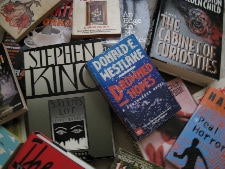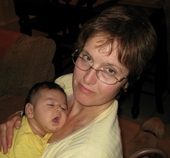
James Patterson is famous for using buckets of chapters in his books -- some of those chapters are no longer than a paragraph -- and he's done okay in the book biz. When Dean adopted the shorter-is-better philosophy for The Silent Corner, he was simply following in the master's footsteps. I've heard a couple of theories as to why the bite-sized chapter is so popular. One of my friends, Sue, believes multiple chapters creates an artificial sense of urgency to a story. Look how quickly those chapters are flying by! -- and the reader doesn't have time to be bored before another chapter has come along. The Good Witch says she thinks it's because today's readers are so easily distracted, they lose their train of thought if they have to stop mid-chapter...so make every chapter so short, they NEVER have to stop mid-chapter. And, yes, the readers might lose their train of thought, anyway, but they won't puzzle over it for long because they have a new chapter to read!
I'm not a fan of the nugget-length chapter, but I'm in the minority here. All I know is, my next manuscript is going to have thirty chapters because that's the deal I made months ago. So how am I doing on that manuscript? I managed absolutely zip-a-dee-doo-dah work on my writing this week. Instead I went to San Antonio. The picture above? A not very good shot of San Antonio.

When one of our family members asked if we wanted to see the Alamo, I told him, "I think I've heard of that. What is the Alamo, exactly?" "You don't remember the Alamo?!" he replied, shocked, and I told him I was only kidding. I don't think he believed me. This is my cell phone shot of the Alamo, which is much smaller than I imagined from the movies. It was fun to see but, overall, my feeling is I won't need to see it again for a decade or so.

But then there was the heat....
How hot was it? This is the gooey image of the vitamins I left in the car one morning, and only remembered by the afternoon. It was sweltering in Texas, sweltering in New Mexico, and sweltering in Arizona when we returned. When we stopped for lunch in Phoenix, it was 119 degrees. But it was, according to Glynn, "A dry heat. A terrible, strength-sapping, life-devouring dry heat" so we had that going for us.
Now that I'm home, it's time to focus on that slow-growing manuscript. If this is the last blog you see for a few weeks, please know I'm hard at work, trying to finish...well, some piece of the story. It's time, don't you think?





 RSS Feed
RSS Feed
